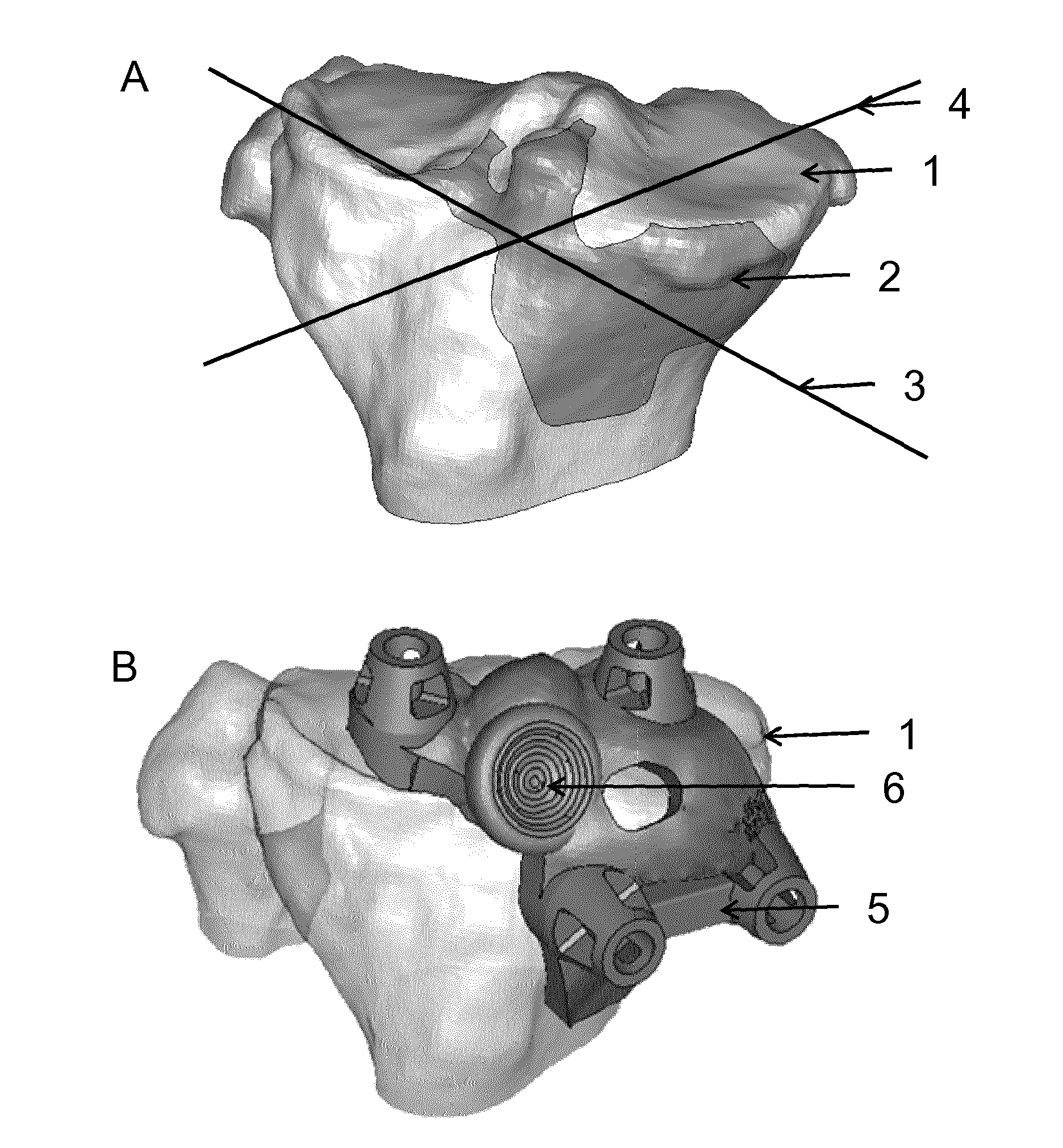Guides with pressure points
a technology of pressure points and guides, applied in the field of guides with pressure points, can solve problems such as deviations from surgical planning, operator uncertainty, and incorrect placement of patient-specific devices
- Summary
- Abstract
- Description
- Claims
- Application Information
AI Technical Summary
Benefits of technology
Problems solved by technology
Method used
Image
Examples
example 1
[0086]The present example provides a detailed description of a specific embodiment wherein an envisioned patient-specific device is improved by providing thereon a push feature for accurately positioning said device.
[0087]In order to identify the optimal position and orientation of the push feature, the axis of least-constrained direction for rotation and translation must be determined. This is illustrated in FIGS. 1A and 1B.
[0088]The present example starts from an existing patient-specific guide. The contact surface (2) of said guide on the anatomical part (1) is identified (see FIG. 2A), and data related to the contact surface may be imported into a computing environment, such as Matlab. The faces of the contact surface (2) are represented by their midpoints with coordinates ri and unit outward normal vector ni, A wrench vector wi, is created for each of the N different contact points using formula (1).
[0089]wi=[nini×ri](1)
[0090]As the preprocessing phases may result in an irregul...
example 2
[0104]The present example, illustrated by FIGS. 3 and 4, provides various alternative push features that can be provided onto a patient specific device. The push features may for instance be a finger-pit (FIG. 3A), one or more buttons (FIG. 3B), a handle (FIG. 4A), a grip (FIGS. 4B and 4C) or a handle provided with one or more finger pits or buttons (FIG. 3C).
example 3
[0105]FIGS. 5 A and B illustrate a patient-specific device according to particular embodiments. The patient-specific device is a surgical guide for guiding a shoulder surgery, and comprises a support structure (7) and a guiding feature (8), more particularly a drill guide. The surgical guide is intended for positioning onto an anatomical part (1), more particularly a patient's glenoid. Therefore comprises several patient-specific contact surfaces (2) which are at least partially complementary to surfaces on or around a patient's glenoid. FIGS. 6 A and B illustrates a shoulder joint, with the patient-specific surgical device (5) positioned on the glenoid (1) via the contact surfaces.
[0106]The guide comprises a dedicated push feature (6), more particularly a handle. The orientation and position of the handle facilitates applying a force to the device perpendicular to the axis of least-constrained rotational direction of the guide on the glenoid, parallel to the axis of least-constrain...
PUM
| Property | Measurement | Unit |
|---|---|---|
| force | aaaaa | aaaaa |
| pressure | aaaaa | aaaaa |
| magnetic resonance image | aaaaa | aaaaa |
Abstract
Description
Claims
Application Information
 Login to View More
Login to View More - R&D
- Intellectual Property
- Life Sciences
- Materials
- Tech Scout
- Unparalleled Data Quality
- Higher Quality Content
- 60% Fewer Hallucinations
Browse by: Latest US Patents, China's latest patents, Technical Efficacy Thesaurus, Application Domain, Technology Topic, Popular Technical Reports.
© 2025 PatSnap. All rights reserved.Legal|Privacy policy|Modern Slavery Act Transparency Statement|Sitemap|About US| Contact US: help@patsnap.com



